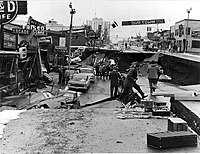History of Anchorage, Alaska
After congress approved the completion of the Alaska Railroad from Seward to Fairbanks in 1914, it was decided that a new town should be built as a port and rail hub along the route.
Survey parties visited the area in 1914 and researched possible routes for the rails and options for siting the new town.
Anchorage was originally settled as a tent city near the mouth of Ship Creek in 1915, and a planned townsite was platted alongside the bluff to the south.
Largely due to the military presence and resource development activities throughout Alaska, Anchorage has enjoyed significant boosts to its population and economic base from 1940 to the present.
The 1964 Alaska earthquake outright destroyed or caused significant damage to most of the Anchorage neighborhoods adjacent to Knik Arm, including its downtown.
According to archaeological evidence discovered at Beluga Point along the Turnagain Arm, just south of modern-day Anchorage, the Cook Inlet had been inhabited, at least seasonally, by Alutiiq Eskimos beginning between 5000 and 6000 years ago.
In summer they tended to fish along coastal streams and rivers, living in portable, dome-shaped tents constructed out of local willow or birch branches and covered with animal skins.
Upon first sighting the inlet, and the mountains surrounding it on all sides, Cook planned to pass it by, but at the urging of John Gore and many others of his crew, he decided to explore the area in order to assuage his men.
As Cook sailed away, many Natives stood along the shores of the inlet waving skins or spreading their arms wide in gestures of peace.
Facing financial difficulties, Tsar Paul I gave Shelekhov-Golikov sole monopoly over Alaskan trade, under the direction of Alexander Baranov, which became the Russian-American Company.
In 1849, the Russians sent a mining engineer to survey the area, who found small amounts of gold and deposits of coal nearby.
By 1850, the former employees of the company had created a small agricultural community in nearby Eklutna, and a Russian Orthodox church was built at Knik.
[6] In 1867, U.S. Secretary of State William H. Seward brokered a deal to purchase Alaska from a debt-ridden Imperial Russia for $7.2 million – about two cents an acre.
The fur trade was still a profitable enterprise, and many of the mountain ranges formed natural funnels leading to the Cook Inlet, along a variety of trails that had been used for centuries by Native tribes.
With deposits of coal and vast growths of lumber in the Matanuska and Susitna Valleys, and dog sleds packed with gold arriving from strikes in places like Iditarod, population began to rise in these areas and producers were in need of a way to get their goods to market.
[9] In 1914, congress passed the Alaska Railroad Act, and the Secretary of the Interior formed the Alaska Engineering Commission, consisting of Thomas Riggs Jr., William C. Edes, and Frederick Mears.The commission hired several survey teams who spent the summer scouting possible routes for a railroad, primarily to bring coal from the mines in Matanuska and Healy to a deep-water port.
On April 10, 1915, Wilson chose the "Susitna route", from the northern coal-mines in Nenana, deep in the interior of Alaska near Fairbanks, south to Healy and then to the Matanuska coal mines, and down through the Kenai Peninsula to the town of Seward; a deep-water port relatively free of ice where the coal could be loaded onto large bulk carrier ships.
Mears arrived to find over 2000 people living on the flats surrounding Ship Creek in ragged tents and makeshift shelters, and unsanitary conditions starting to develop.
To ensure this, an experimental plan was put into place where land was auctioned off to the people but could be forfeited if a person was caught violating the alcohol laws.
However, in August the people were given a chance to vote on the name, and many options were tossed about, including "Matanuska", "Ship Creek", "Homestead", "Terminal", and "Gateway".
Elmendorf Air Force Base and Fort Richardson were constructed, and Anchorage became the headquarters of the Alaska Defense Command.
Capital projects and an aggressive beautification program, combined with far-sighted community planning, greatly increased infrastructure and quality of life.


